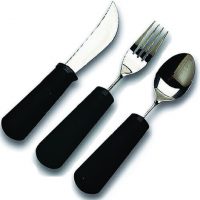Eating is not only an enjoyable experience but a necessity for health and wellbeing. Certain conditions like arthritis, stroke, tremors and general weakness may make it difficult for a person to participate in this important daily activity. Difficulty with eating may cause a person to eat less than they need for healthy nutrition, may limit the types of food a person can enjoy, or even cause someone to be reluctant to go out to dinner and socialize with friends. For those who may be experiencing limitations in eating due to hand problems, adaptive eating utensils and equipment may help.

Adaptive utensils and eating equipment may improve your ability to successfully bring food to your mouth. When it comes to choosing utensils, there are many options. Large grip utensils have a built up handle to make grasping the utensil easier and are available for forks, spoons and knives. The wider grip puts less stress on the small joints of your hand and requires less grip strength to hold the utensil. Handles come in many different styles. Commercial large grip utensils are either plastic or rubber, and to increase comfort, some are ribbed or contoured to fit your hand.
The size of the grip varies, as well, so some large grip utensils may be more comfortable than others. If you prefer to use utensils you already own, inexpensive foam tubing can be purchased to make a larger grip handle. Tubing can be purchased with different sized holes (to accommodate the thickness of your utensils) and can be cut to fit the length of the utensil’s handle. The tubing easily slides onto the handle of the fork, spoon, or knife thereby making it easier to grasp and hold. Many types of foam tubing are slip-resistant and dishwasher safe.
Universal cuffs are another option for those who wish to use their own utensils but may not have the mobility or strength to maintain a grasp during eating. Universal cuffs are adjustable bands that fit around the palm section of your hand. Because of the way it is positioned, no grip strength is required to use a universal cuff. The cuff has a small pocket on the palmar surface of the device. A fork or spoon handle may be placed into the pocket, providing a stable and secure position for use of the utensil to eat. As the name implies, universal cuffs can also be used to hold a variety of objects such as a toothbrush or pen.
Most adaptive eating utensils are of low cost, averaging under $15. Items are available online, at national large-chain retailers and local pharmacies. While there are a vast amount of commercial options, it is also possible to adapt equipment yourself, using materials that you may already own. For example, to make a large grip utensil, masking tape could be wrapped around the utensil until the grip is large enough for comfort.
Using adaptive eating utensils is just one way of increasing your participation in eating. There are other types of adaptive devices that can also help to decrease difficulty in eating: special knives that allow a person to cut food more safely and efficiently, plates with curved edges and rims to reduce spilling, non-slip matting (often sold as shelf-liner) can keep plates from sliding, and cups with lids and special handles to keep drinks from spilling.
If you or a loved one is having difficulty with eating or managing other daily activities, ask your doctor for a referral to occupational therapy. Occupational therapists can offer additional ideas, adaptive devices and strategies that can help you keep your independence and stay safe. PSN
By Devra Alper

